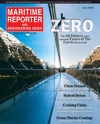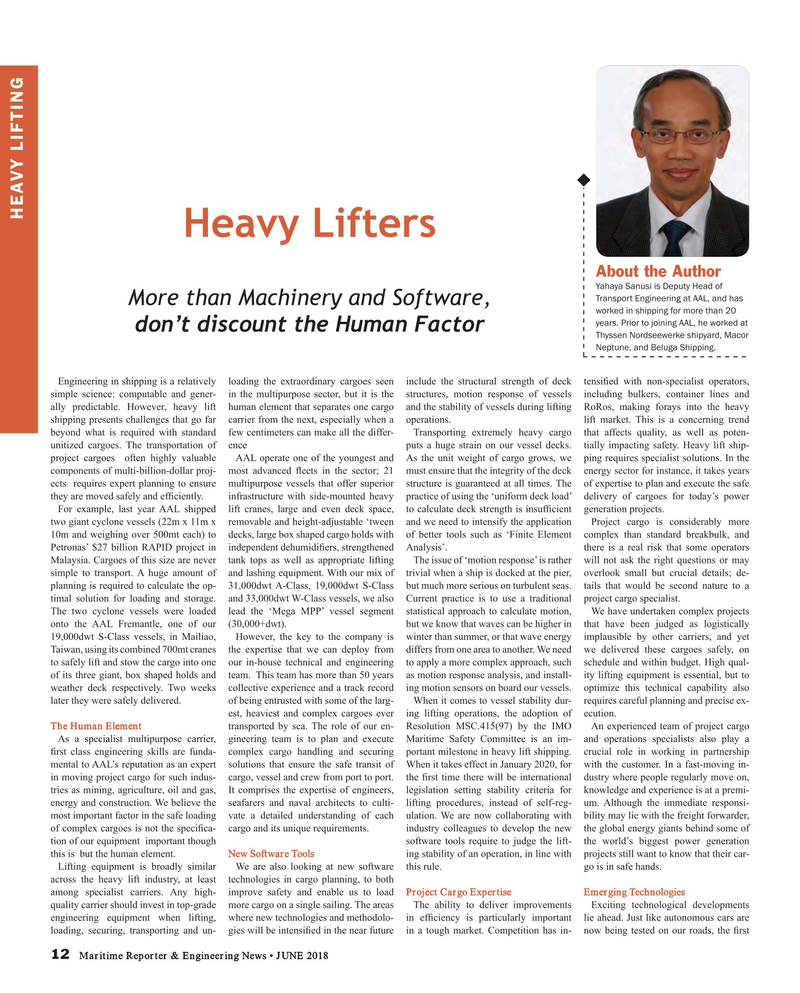
Page 12: of Maritime Reporter Magazine (June 2018)
Green Marine Technology
Read this page in Pdf, Flash or Html5 edition of June 2018 Maritime Reporter Magazine
HEAVY LIFTING
Heavy Lifters
About the Author
Yahaya Sanusi is Deputy Head of
Transport Engineering at AAL, and has
More than Machinery and Software, worked in shipping for more than 20 years. Prior to joining AAL, he worked at don’t discount the Human Factor
Thyssen Nordseewerke shipyard, Macor
Neptune, and Beluga Shipping.
Engineering in shipping is a relatively loading the extraordinary cargoes seen include the structural strength of deck tensi? ed with non-specialist operators, simple science: computable and gener- in the multipurpose sector, but it is the structures, motion response of vessels including bulkers, container lines and ally predictable. However, heavy lift human element that separates one cargo and the stability of vessels during lifting RoRos, making forays into the heavy shipping presents challenges that go far carrier from the next, especially when a operations. lift market. This is a concerning trend beyond what is required with standard few centimeters can make all the differ- Transporting extremely heavy cargo that affects quality, as well as poten- unitized cargoes. The transportation of ence puts a huge strain on our vessel decks. tially impacting safety. Heavy lift ship- project cargoes often highly valuable AAL operate one of the youngest and As the unit weight of cargo grows, we ping requires specialist solutions. In the components of multi-billion-dollar proj- most advanced ? eets in the sector; 21 must ensure that the integrity of the deck energy sector for instance, it takes years ects requires expert planning to ensure multipurpose vessels that offer superior structure is guaranteed at all times. The of expertise to plan and execute the safe they are moved safely and ef? ciently. infrastructure with side-mounted heavy practice of using the ‘uniform deck load’ delivery of cargoes for today’s power
For example, last year AAL shipped lift cranes, large and even deck space, to calculate deck strength is insuf? cient generation projects. two giant cyclone vessels (22m x 11m x removable and height-adjustable ‘tween and we need to intensify the application Project cargo is considerably more 10m and weighing over 500mt each) to decks, large box shaped cargo holds with of better tools such as ‘Finite Element complex than standard breakbulk, and
Petronas’ $27 billion RAPID project in independent dehumidi? ers, strengthened Analysis’. there is a real risk that some operators
Malaysia. Cargoes of this size are never tank tops as well as appropriate lifting The issue of ‘motion response’ is rather will not ask the right questions or may simple to transport. A huge amount of and lashing equipment. With our mix of trivial when a ship is docked at the pier, overlook small but crucial details; de- planning is required to calculate the op- 31,000dwt A-Class, 19,000dwt S-Class but much more serious on turbulent seas. tails that would be second nature to a timal solution for loading and storage. and 33,000dwt W-Class vessels, we also Current practice is to use a traditional project cargo specialist.
The two cyclone vessels were loaded lead the ‘Mega MPP’ vessel segment statistical approach to calculate motion, We have undertaken complex projects onto the AAL Fremantle, one of our (30,000+dwt). but we know that waves can be higher in that have been judged as logistically 19,000dwt S-Class vessels, in Mailiao, However, the key to the company is winter than summer, or that wave energy implausible by other carriers, and yet
Taiwan, using its combined 700mt cranes the expertise that we can deploy from differs from one area to another. We need we delivered these cargoes safely, on to safely lift and stow the cargo into one our in-house technical and engineering to apply a more complex approach, such schedule and within budget. High qual- of its three giant, box shaped holds and team. This team has more than 50 years as motion response analysis, and install- ity lifting equipment is essential, but to weather deck respectively. Two weeks collective experience and a track record ing motion sensors on board our vessels. optimize this technical capability also later they were safely delivered. of being entrusted with some of the larg- When it comes to vessel stability dur- requires careful planning and precise ex- est, heaviest and complex cargoes ever ing lifting operations, the adoption of ecution.
The Human Element transported by sea. The role of our en- Resolution MSC.415(97) by the IMO An experienced team of project cargo
As a specialist multipurpose carrier, gineering team is to plan and execute Maritime Safety Committee is an im- and operations specialists also play a ? rst class engineering skills are funda- complex cargo handling and securing portant milestone in heavy lift shipping. crucial role in working in partnership mental to AAL’s reputation as an expert solutions that ensure the safe transit of When it takes effect in January 2020, for with the customer. In a fast-moving in- in moving project cargo for such indus- cargo, vessel and crew from port to port. the ? rst time there will be international dustry where people regularly move on, tries as mining, agriculture, oil and gas, It comprises the expertise of engineers, legislation setting stability criteria for knowledge and experience is at a premi- energy and construction. We believe the seafarers and naval architects to culti- lifting procedures, instead of self-reg- um. Although the immediate responsi- most important factor in the safe loading vate a detailed understanding of each ulation. We are now collaborating with bility may lie with the freight forwarder, of complex cargoes is not the speci? ca- cargo and its unique requirements. industry colleagues to develop the new the global energy giants behind some of tion of our equipment important though software tools require to judge the lift- the world’s biggest power generation this is but the human element. New Software Tools ing stability of an operation, in line with projects still want to know that their car-
Lifting equipment is broadly similar We are also looking at new software this rule. go is in safe hands. across the heavy lift industry, at least technologies in cargo planning, to both among specialist carriers. Any high- improve safety and enable us to load Project Cargo Expertise Emerging Technologies quality carrier should invest in top-grade more cargo on a single sailing. The areas The ability to deliver improvements Exciting technological developments engineering equipment when lifting, where new technologies and methodolo- in ef? ciency is particularly important lie ahead. Just like autonomous cars are loading, securing, transporting and un- gies will be intensi? ed in the near future in a tough market. Competition has in- now being tested on our roads, the ? rst 12 Maritime Reporter & Engineering News • JUNE 2018
MR #6 (10-17).indd 12 MR #6 (10-17).indd 12 6/6/2018 9:26:22 AM6/6/2018 9:26:22 AM

 11
11

 13
13
